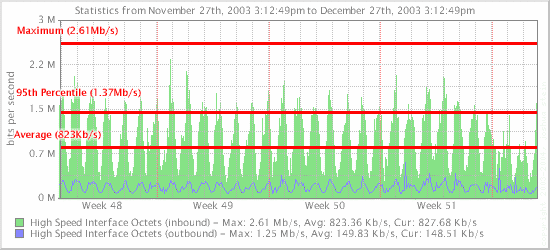Understanding 95th Percentile BilLING
What is the 95th percentile?
The 95th percentile is a mathematical calculation widely used to evaluate the regular, sustained utilization of your Internet connection.
This calculation says that 95% of the time, your usage is at or below this amount. With the top 5% of the bandwidth usage being short spikes of atypical usage, they are discarded.
It is important to realize that the 95th percentile is not an average, but a representation of the actual bandwidth used.

How does DLS calculate the 95th percentile?
DLS’ statistics system collects samples from its routers and switches every 5 minutes. Since the samples are taken every 5 minutes, the data sample represents a 5 minute averaged bits per second value. At the end of a term (such as a customer’s billing cycle), these 5 minute bit per second values are gathered and sorted. The top 5% of the values, representing the highest points of bandwidth usage during the month, are discarded. The remaining highest sample of data is considered the 95th percentile sample and is used by our billing system.

How does DLS bill based on the 95th percentile?
Once the 95th percentile value is generated, it is compared to the amount allowed in your contract. If you have used more bandwidth than allowed, you are charged overusage based on the difference between the two numbers. For the amount of bandwidth allowed for your DLS connection and for overusage prices, please consult your contract or contact your DLS sales representative.

A graphical example
The following is a typical graph (in month view) of a co-located server: This graph shows constant peaks and valleys every day, with a maximum inbound rate of 2.6 megabits per second. The 95th percentile formula removes the top 5 percent of these samples, putting the normal rate at only 1.37 megabits per second. This customer would be billed at 1.37 megabits per second for the month, assuming the customer’s billing cycle ended today.